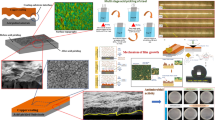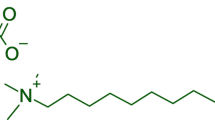Abstract
A silver- and zinc-containing zeolite matrix (AgION) used as a coating for stainless steel was tested for antimicrobial efficacy against Escherichia coli 25922, Staphylococcus aureus 25923, Pseudomonas aeruginosa 27853, and Listeria monocytogenes 7644. Assays were performed on flat coupon surfaces and in formed steel cups. AgION reduced microbial colony-forming units when compared to uncoated steel surfaces under all conditions tested. Percent reductions ranged from 84.536 to 99.999 after 4 h exposure, and from 99.992 to 100 after 24 h in all cases. The durability of the coatings declined most markedly when the coating had been applied with a wet process and scrubbed between uses with a test tube brush. Powder-coated surfaces cleaned with a towel retained a high degree of activity after five cycles of use.

Similar content being viewed by others

References
Akiyama H, Yamasake O, Kanzaki H, Tada J, Arata J (1998) Effects of sucrose and silver on Staphylococcus aureus biofilms. J Antimicrob Chemother 42:629–634
Anraku Y, Goto F, Kin E (1975) Transport of sugars and amino acids in bacteria. XIII. Mechanism of selective inhibition of the active transport reactions for proline, leucine, and succinate by zinc ions. J Biochem 78:149–157
Buccellato GM, Robideau RR, Hoffmann KM, Jacobs GF (1998) Addition of antimicrobial agents to pavement marking materials. Official Gazette of the United States Patent and Trademark Office Patents 1209:3211
CDC (2001) Preliminary FoodNet Data on the incidence of foodborne illnesses—selected sites, United States 2001. MMWR Morb Mortal Wkly Rep 50:241–246
Kalyon BD, Olgun U (2001) Antibacterial efficacy of triclosan-incorporated polymers. Am J Infect Control 29:124–126
Kraft CN, Hansis M, Arens S, Menger MD, Vollmar B (2000) Striated muscle microvascular response to silver implants: a comparative in vivo study with titanium and stainless steel. J Biomed Mater Res 49:192–199
Levy SB (2001) Antibacterial household products: cause for concern. Emerg Infect Dis 7:512–515
Loke W-K, Lau S-K, Yong LL, Khor E, Sum CK (2000) Wound dressing with sustained anti-microbial capability. J Biomed Mater Res 53:8–17
Malassiney P, Goeau-Brissonniere O, Coggia M, Pechere J-C (1996) Rifampicin loading of vascular grafts. J Antimicrob Chemother 37:1121–1129
Mixon GC (1998) Antimicrobial gloves and a method of manufacture thereof. Official Gazette of the United States Patent and Trademark Office Patents 2:1336
Nakashima H, Matsunaga I, Miyano N, Kitagawa M (2000) Determination of antimicrobial agents in non-formalin adhesives for wallpaper. J Health Sci 46:447–454
Nikawa H, Yamamoto T, Hamada T, Rahardjo MB, Murata H, Nakanoda S (1997) Antifungal effect of zeolite-incorporated tissue conditioner against Candida albicans growth and/or acid production. J Oral Rehabil 24:350–357
Paddock ML, Graige MS, Feher G, Okamura MY (1999) Identification of the proton pathway in bacterial reaction centers: inhibition of proton transfer by binding of Zn2+ or Cd2+. Proc Natl Acad Sci USA 96:6183–6188
Rees EN, Tebbs SE, Elliott TSJ (1998) Role of antimicrobial-impregnated polymer and Teflon in the prevention of biliary stent blockage. J Hosp Infect 39:323–329
Ruggiero MA, Magan P, Robitaille TE, Roth RP, Irovando JJ (1998) Biocide plus surfactant for protecting carpets. Official Gazette of the United States Patent and Trademark Office Patents 121:1487
Scannell AGM, Hill C, Ross RP, Marx S, Hartmeier W, Arendt EK (2000) Development of bioactive food packaging materials using immobilised bacteriocins lacticin 3147 and Nisaplin(R). Int J Food Microbiol 60:241–249
Schierholz JM, Wachol-Drewek Z, Lucas L, Pulverer G (1997) Activity of silver ions in different media. Zentralbl Bakteriol 287:411–420
Schierholz JM, Rump AFE, Pulverer G, Beuth J (1998) Anti-infective catheters: novel strategies to prevent nosocomial infections in oncology. Anticancer Res 18:3629–3638
Sessa R, di Pietro M, Schiavoni G, Santino I, Altieri A, Pinelli S, del Plano M (2002) Microbiological indoor air quality in healthy buildings. Microbiologica 25:51–56
Silver S, Lo JF, Gupta A (1999) Silver cations as an antimicrobial agent: clinical uses and bacterial resistance. APUA Newslett 17:1–3
Silver News (1997) Germ-killing silver showing up in hundreds of everyday products: Japanese leading the charge for silver-based hygienic products. April/May:1–2
Stetzenbach LD (1998) Microorganisms and indoor air quality. Clin Microbiol Newslett 20:157–161
Stickler DJ (2000) Biomaterials to prevent nosocomial infections: is silver the gold standard? Curr Opin Infect Dis 13:389–393
Subramanyam S, Yurkovetsiky A, Hale D, Sawan SP (2000) A chemically intelligent antimicrobial coating for urologic devices. J Endourol 14:43–48
Thurman RB, Gerba CP (1989) The molecular mechanisms of copper and silver ion disinfection of bacteria and viruses. CRC Crit Rev Environ Contam 18:295–315
Vermeiren L, Devlieghere F, Debevere J (2002) Effectiveness of some recent antimicrobial packaging concepts. Food Addit Contam 19:163–171
Acknowledgements
The technical assistance of Jim Lewellyn and Matt Renners is gratefully acknowledged. This work was supported by funding from AK Steel Corporation, Middletown Ohio, and by the Miami University Office for the Advancement of Scholarship and Teaching.
Author information
Authors and Affiliations
Corresponding author
Rights and permissions
About this article
Cite this article
Cowan, M.M., Abshire, K.Z., Houk, S.L. et al. Antimicrobial efficacy of a silver-zeolite matrix coating on stainless steel. J IND MICROBIOL BIOTECHNOL 30, 102–106 (2003). https://doi.org/10.1007/s10295-002-0022-0
Received:
Accepted:
Published:
Issue Date:
DOI: https://doi.org/10.1007/s10295-002-0022-0



